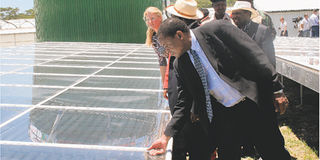Kenya pioneers solar farms in Africa

Solar panels at Bilamashaka flower farm in Naivasha. A wholly solar-powerd firm is set to be launched in June, the first in Africa.
File| Nation
What you need to know:
- Sh32 billion facility to reduce over reliance on rain fed power supply
A solar powered facility could elevate Kenya as the first country in Africa to establish a green farm that uses renewable energy.
Kenya Agricultural Research Institute (Kari) says farmers are expected to come have renewable energy farm in June this year that is also expected to serve as a tourist attraction.
The facility, which is expected to take $4 million (about Sh32 billion), will pave way for an agrarian system that is less dependent on rain-fed agriculture, according to Kari director Ephraim Mukisira.
He said every operation on the green farm, which will include crops and the rearing of livestock, will be powered by solar.
A hundred acres of land at Kari Muguga have been set aside to accommodate the facility, which is already running trials with a new greenhouse technology imported from the South Korean Government, and which the institution says is attractive to urban agriculture.
“This is a new concept that demonstrates that research and science is moving away from traditional to more exciting settings like the green villages,” says Dr Mukisira. “The future of agriculture is to increase productivity and conserve the environment.”
According to Dr Patrick Gicheru, the director Kari centre, Kabete, the concept borrows from a World Bank funded carbon benefits scheme in Western Kenya that assesses the possibility of carbon sequestering from both tree and cover crops.
While farmers have to wait for about 20 years to win carbon credits through the planting of trees, Dr. Gicheru says the new model has an edge over the later because it will enlist farmers into the carbon trading scheme through crop production that enriches soil fertility.
“We are trying to find out if there are crops that farmers can sequester carbon from while at the same time ensuring that soil fertility is improved,” says Dr. Gicheru. “This can enable us to have food security as well generate income from carbon trading.”
But there is a catch to the new found windfall that could leave many of them on edge. Last week’s launch of the Africa Carbon Exchange facility raised hopes that farmers could be the big winners in green energy and afforestation projects.
But National Environment Management Authority (NEMA) says farmers will be awarded through carbon trading depending on the types of crops as well as green innovations.
This leaves floriculture and horticulture farmers in a tricky spot because the trading scheme does not recognise the two due to the string of production rules that bind them, according to Malwa Langwen, NEMA’s director for compliance and enforcement.
“The carbon trading scheme will obviously not consinder farmers who have invested in floriculture and horticulture alone,” says Langwen.
“They will have to go a step further and show an appetite for planting trees as well as innovation in renewable energy projects.”
According to Langwen, a partnership between the Africa Carbon Exchange facility and NEMA is in the pipeline that will vet trends in environmental conservation and well forested farms for award of carbon credits.
At an event to mark the launch of the Going Green initiative in Nairobi, Langwen joined other stakeholders in showcasing some of the innovations that may attract the interest of the facility, where eight categories were presented with awards for showing leadership towards a green economy.
Among institutions recognised by the Voices for Environmental Campaign were Mater Hospital, Sun N Sand Beach Resort, Severin Sea Lodge (EA) Limited, East Africa Breweries Limited, Safaricom Ltd, Bamburi Cement Limited, Oshwal Academy and Nakumatt Holdings Limited, among others.



